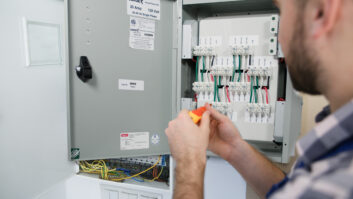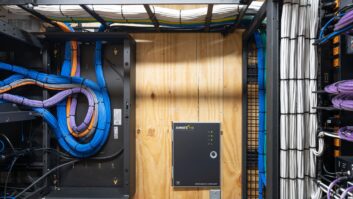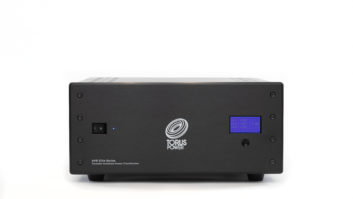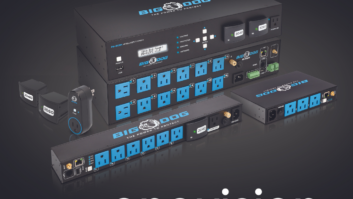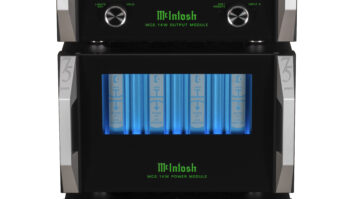Subwoofers come in all shapes and forms. Some are large, some are small, most are black, and most today are self-powered.
In the early days, subwoofers were sometimes passive units that required external amplification and crossover filters. These passive units were usually pretty large to allow low-frequency extension below 30 Hz. Next came self-powered (a.k.a. active) subwoofers that had all of the amplification built-in (assuming, therefore, that you were merely adding a subwoofer as an accessory to an existing system.)
Going active has a number of advantages in addition to convenience. The most obvious benefit is that the power amplifier can be perfectly matched to the driver unit in terms of voltage and current output. Also, the power amplifier can be matched to the driver load impedance characteristics. The cabinet can be made smaller, and a tailored peaking circuit in the amplifier can compensate for the inherent low-frequency roll-off of the cabinet.
Another important advantage is that the active subwoofer can include a limiter circuit. This prevents some of the most annoying problems like audible overload and localization of the subwoofer. Because the amount of bass in film soundtracks can be prodigious (up to 115dB SPL in the room) and because it can take large numbers of large subwoofers to fully produce that peak level, it is a forgone conclusion that a single subwoofer will overload at some point in a loud action scene.
By the way, it would typically take at least four subwoofers with 12-inch drivers and 400 watts behind each driver to reproduce the aforementioned 115dB in a 3,000 cubic foot room! A limiter circuit monitors the level reproduced by the subwoofer and prevents it from exceeding the limit allowed by either amplifier power or driver excursion. It is essentially like a speed governor on a car, and although nobody really likes these pesky things, limiters fulfill a really important role.
If you want to hear how much a subwoofer can overload, turn off all the main speakers and listen to a loud action scene. On a subwoofer with no limiteror a poorly designed oneyou will hear all the clanking and flapping that the midrange sounds from the main speakers usually mask.
Subwoofer localization is by far the largest side effect of uncontrolled overload. Human hearing doesnt localize sounds very well below 100 Hz, so that allows you to place properly filtered subwoofers anywhere you want and anywhere they least interact with the rooms natural acoustic resonances.
Once in overload, however, subwoofers generate distortion products of the incoming signals. These distortion sounds are much higher in frequency content than 100 Hz. As a result, you will clearly localize the subwoofer.
So limiters and matched amplifiers are good for subwoofers, but does the amplifier circuit need to be in the same enclosure as the driver? Not really. In fact, theres a crop of manufacturers specializing in custom A/V gear that are building active subwoofers with external electronics. The largest benefit I see is that the electronics can be rack-mounted along with all the other gear. All you need to run to the subs is speaker wire, instead of AC power and line-level wire. Additionally, the subwoofer cabinets can now be smaller since they dont have to house the amplifier circuitry and heatsinks; thats a good thing when you are trying to conceal the subwoofers in cabinetry or behind a stretched fabric wall. You can easily hide several of these smaller subwoofers behind a fabric and get the frequency response smoothing benefits of a distributed bass layout.
Its important to understand that these active subwoofers with outboard amps behave every bit like a unit with integrated electronics. In other words, the amplifier stage is matched to the subwoofer, the response is tailored through built-in peaking, overload is controlled through a limiter, and the amp is designed for best interface with the driver. They are not passive subwoofers; theyre active subwoofers with external amps.
You may be tempted to substitute the amplifier stage with one of your own selection. If you know exactly what youre doing that may be OK. You will need to know the safe operating area of the power amplifier you want to use so that it interfaces correctly with the drivers impedance characteristics. You will need to know the requisite equalization peaking to compensate for inherent cabinet low frequency roll-off. You will need to know the amplifier clipping voltage and the driver excursion limit so you can match them to each other. And, you will need to provide an external limiter system, and you will need to figure out the appropriate level threshold, compression slope, attack time, and release time.
By this point you have done much of the design engineers work, and youve spent a few days doing it. Be sure its worth the effort and that the project has enough budget allocation before you embark down this path!
Active subwoofers with external amps are the best of all worlds: perfect for custom installation and perfect for a smooth, controlled bass sound character. I spec them in virtually every job now.
Chase Walton contributed to this article.
